The name of Flandria can trace its history back to 1825, when Alexander Claeys, a blacksmith by trade, married into the Dombrecht family, who owned a blacksmith’s shop at Zedelgem in Belgium. Alexander’s dowry was the forge, where he set up his own business. His son Louis began making agricultural tools, and the first family bicycle was manufactured in 1896. Louis had seven children, and Aimé particularly was to become the driving force behind developing the family business, and together with his brothers and sisters, they chose De West-Vlaamsche Leeuw (The West-Flemish Lion) as the brand for their cycles. By 1910 the Claeys had sold 150 bicycles, which were becoming a favoured mode of transport for working men of the time.
After the First World War, four of the brothers: Alidor, Aimé, Remi, and Jerome, founded the Werkhuizen Gebroeders Claeys (Claeys Brothers Workshops Limited) in 1924, for the further production of bicycles and many other products, including stoves, children’s tricycles, buggies, and invalid carriages. By 1927 the new company had already produced over 25,000 bicycles.
During World War II, Aimé decided to modernise the factory and its production techniques using new technologies, and in 1940 changed the brand name of the bicycles from De West-Vlaamsche Leeuw to Flandria.
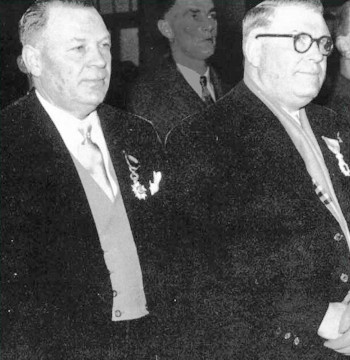
Remi Claeys (1897–1974)
Aimé Claeys (1895–1972)
Immediately after the war Aimé embarked on the speculative purchase of more modern machinery from America and England, and more new equipment was brought in every year to increase efficiency and output. The post-war market for bicycles was dramatically increasing, so a second factory was built in Zedelgem to keep up with the demand.
In 1949, Remi Claeys founded his own electrically welded steel tube manufacturing plant, which was established on vacant plots between the railway, the station, and the Kortemarkstraat in Lichtervelde. His son André developed the new project from concept, layout and construction of the works, and when production started at the end of August 1950, André took over the daily management producing tubes for the furniture industry (chairs), fabrication construction, and for water and gas pipes. By 1951 the company was selling more than 250,000 bicycles annually, from which motorised cycles were introduced using German 40cc Rex engines. The Rex was replaced by Flandria’s own engine in 1952, then two-gear mopeds were added to the Flandria range in 1953; in the first year of production more than 25,000 were sold. At this time Flandria models weren’t being sold in the Netherlands, but Flandria supplied engines to the A van Rossom Co in Dordrecht for fitting into its Avros brand mopeds (later renamed as Avaros).
In 1955, Aimé Claeys purchased an industrial site in Warneton to set up two new moped assembly lines, and even a midget car was presented at the Brussels Motor Show, but it was only a prototype that never went into production.
A French Flandria company was founded in 1956 by Aimé Claeys to manufacture and import bicycles, mopeds and lawnmowers.
While it appeared that there were no limits to the continuing expansion of the company, behind the scenes, all was not well, as sibling rivalry was beginning to surface. Aimé and Remi often disagreed, which eventually led to a bitter family feud that finally came to a head in 1956. Werkhuizen Gebroeders Claeys was dissolved, and the new factory in Zedelgem was split between the two brothers, with the gates bricked shut to divide the factory into two and, famously, a brick wall was built right down the middle of the factory!
So bitter was the feud that brand-new, unmoveable machines, costing millions of Belgian Francs, were reportedly cut in half, and the wall built straight through them, because neither brother would make any concession to the other.
Aimé kept the Flandria brand name, calling his new company A.Claeys-Flandria, whilst the factory in Lichtervelde remained in Remi’s hands, and he named his half of the Zedelgem factory Remi Claeys-Superia. This only caused the quarrel to escalate further, since Superia was the name of the best selling Flandria moped at the time.
Moped production continued on both sides of the wall, and it was inevitable that the two brands Flandria and Superia were going to be very similar, as Remi often copied Flandria’s models as he didn’t share his older brother’s engineering inspiration, and neither matched Aimé’s sales success. Since Aimé refused to provide Flandria engines to his younger brother, Superia purchased proprietory engine units from Sachs, Victoria and Pluvier instead.
The Superia company established a further assembly site at Sluis in Zeeland-Flanders, where it also manufactured baby strollers, junior strollers and rolling toys, and Remi introduced his first extrusion press for the production of aluminum profiles.
Light motor cycles and scooters had been included in the Flandria range up to 1957, when the company decided to concentrate solely on mopeds, while on the other side of the semi-detached factory, Superia continued to offer a range of light motor cycles with 120, 125, 175, 200 and 250cc Ilo proprietary engines, though these motor cycles were neither produced nor assembled in-house. Before the business split, these same motor cycles had been sold under the Flandria brand, but the bikes were actually built and factored from the Gillet-Herstal factory in Wallonia, but it was Remi who took over the collaboration contract with Gillet for a few more years. The earlier Flandria and later Superia badges on the tank of these motor cycles was practically the only component that was different.
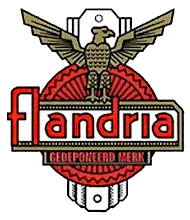
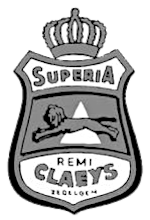
The dispute raged into 1958, when a Belgian moped magazine reported that the two brands ‘were very similar’, for which the editors received a letter, in which it was made clear that ‘there were no similarities between Flandria and Superia’.
1959 would bring the most successful period for Aimé, which saw the formation of the Flandria professional cycling team; this would go on to become one of the most successful and influential cycle racing competition teams of all-time. Both companies continued from their adjacent factories, with both making bicycles, but it was Flandria that became the largest supplier of cycles and bicycle components in Western Europe, and began international sales of its mopeds, which would become exported to customers across the world during the 1960s and into the 70s. At its peak, production of bicycles topped 350,000 per annum.
In 1963, Remi Claeys Tubing started production of seam-welded tubes in aluminium, and further fabricated steel plate radiators, gas convectors, and boilers for central heating, while on the other side of the wall, Flandria continued to supply automatic, touring, and sports mopeds.
The Dutch Avaros brand ceased in 1965, and Aimé subsequently adopted the Caravelle, Kingline, Record, and Canberra Rally moped models for continuation in the Flandria range.
In 1968, Aimé Claeys’s son-in-law, Germain Vandenbroucke (1925-2010), introduced a strategic diversification for French Flandria into the production of aluminium extrusion profiles by investment into their first 2,000-tonne aluminium press. Within a few years, two other presses, a precision mechanical workshop for the manufacture of dies, and a foundry were further added to complement the process.
Flandria also established factories in France, Morocco and Portugal, and Flandria engines were manufactured under license at Figueres in Spain, and different moped models were built in all these countries.
Although the steady expansion of Flandria’s cycle and moped business had been consistent over many years, its decline was contrastingly quite sudden. Though bicycle sales remained strong, home market moped sales began to fall off rapidly as new Belgian legislation making the wearing of helmets mandatory, while a recent law limiting mopeds to 40km/h (25mph) contributed to a further decline in their popularity. Production of mopeds crashed from over 100,000 units in 1969, to barely half that number in 1973.
Remi Claeys’s Superia company dropped its own-built motorised products in the early 1970s in favour of buying in Italian manufactured rolling chassis from Testi and Romeo, and fitting Minarelli engines.
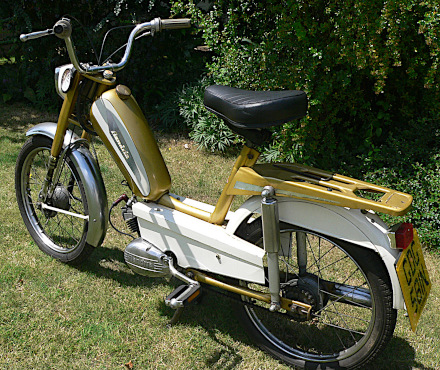
Glass's Index lists Flandria 147 F, 147 AF, and 147 AF-A models first imported to the UK in May 1974, but our feature bike is an 047 AF-A model, which is clearly a 1975 British registered moped with telescopic forks, swing-arm twin-shock rear suspension, but doesn’t appear to have been listed in the UK according to Glass’s, or perhaps they got their model numbers muddled up?
047 models have a separate fuel tank on the tubular main-frame down tube, whereas 147 models are differentiated by a pressed-steel main frame with integral tank.
047 F and 147 F models were versions with a rigid rear frame, while FA models had Anker-Laura engines in rear sprung frame.
The ‘round crankcase’ Flandria moped engine had appeared in 1966, and was introduced as a single-speed automatic with centrifugal pressure plate clutch, along with a four-speed hand-change version for sports models.
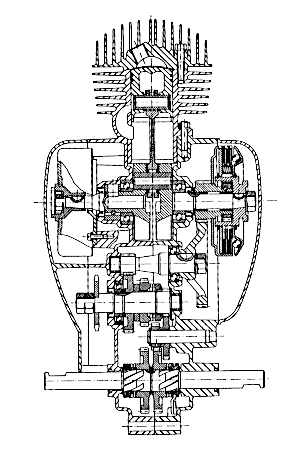
The Flandria isn’t one of the whirling pulleys and flailing belts mopeds, it has a compact unit engine with smart polished aluminium side casings, cast iron barrel 40mm bore × 39.7mm stroke for 49.9cc and a 7.8:1 compression aluminium cylinder head (no power rating is given by the manufacturer). The A33-204 Encarwi 12mm carb doesn’t fix to the cylinder however, but bolts onto the crankcase behind it, since the engine is equipped with rotary-valve induction—which is rather neat! At a casual glance the Flandria might easily be mistaken for a period Moby since the styling is fairly similar, but look again, and subtle differences are revealed. Tyres are sized 2.25 × 16, and measuring just 65 inches from nose-to-tail, giving a short 41½-inch wheelbase, the AF-A is a ‘compact’ machine, and may not readily accommodate tall or larger sized riders. There’s a nice chrome torpedo silencer on the Flandria, but the sheet steel side-panels look crudely formed, with flat tops, which it may be surprising to discover have a functional intention! It became popular practice on the continent to ride mopeds ‘scooter style’ with feet off the pedals, resting inboard on the frame instead. Many riders may have noticed trims on their own typically European commuter-peds, and several makers employed the feature: Batavus, Garelli, Mobylette, Piaggio, and even some European-assembled Honda mopeds. Maybe not a riding practice adopted in Britain, but it is out there! Our 047 doesn’t have foot trims on the top of its panels, though the 147 did (which had the same side panels), so perhaps the untrimmed 047 panels may suggest it was the budget model?
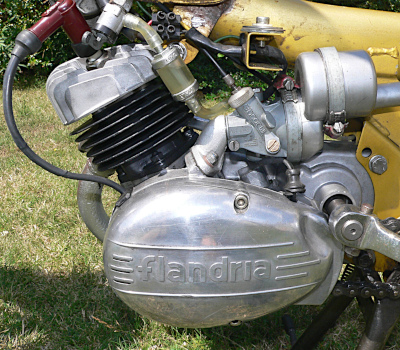
Now you come to the greatest puzzle, how to actually start it? If you pedal away, it simply pedals like a bicycle. There’s no trigger on either of the lever brackets to lock the clutch, and push the bike along and it just freewheels. No levers, no switches, nothing—totally baffling! Until you go to back pedal—and only then the engine turns over! The intention with the Flandria is to use either pedal as if it’s a kick starter, alternatively pedal it up the road then back-pedal as you continue to coast, when the engine starts and takes over. Certainly a novelty!
It’s also noticeable that there’s no choke trigger, nor any choke control at the carb, and that’s not because there’s an automatic choke either … there simply isn’t one, but if you take out the air-slide you’ll see that when the throttle is closed it reveals ports that draw air through the slide, which lifts extra fuel up through the main jet.
This seems to work pretty well in summer, but we do wonder about winter?
There’s also no throttle stop screw to the carb, so the idle speed can only be tuned by the throttle cable adjusters. This isn’t a particularly reliable method to set tickover, as turning the handlebars will often change the revs, and a steady low tickover is preferable on the auto Flandria since the clutch can readily engage if the revs increase.
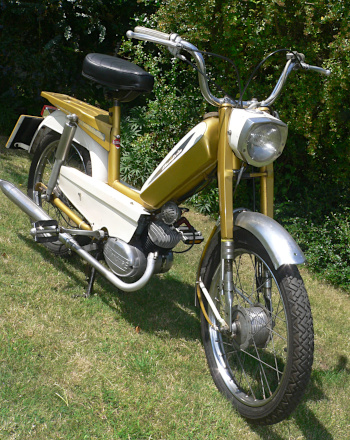
The automatic clutch is unusual in being a centrifugally operated pressure plate (Dutch Anker-Laura motors also used this system) that engages quite readily at low revs, so the engine has to labour up to speed, though it is somewhat helped by the rotary valve induction, which improves torque at low revs, and can be rider-assisted by the high geared pedal ratio if required. The clutch operation can come as something of an unexpected trick when you shut down the throttle, since in the same way as the clutch readily engages when pulling away, it just as instantly disengages the motor off load, and you suddenly find yourself freewheeling along in neutral with no engine braking! It’s quite a surprise to experience if you’re not expecting it, and it’s a good job the brakes are so effective. They prove to deliver good firm stopping.
We never expected the fifty year old VDO 60mph speedometer set to give accurate results, so the road test was paced and, while the maximum indicated reading was fixed at 30mph, our pacer reported the bike generally running along at 31mph and, a couple of times, topping out at a best of 33mph—at one point along the flat while catching a tailwind and again on a long light downhill run.
Helped by the rotary valve, the Flandria gives a strong account of itself against headwinds and uphill, which greatly helps to maintain a good average performance, despite the limited top speed.
Though all the baffles seem to be present, the throbbing exhaust note becomes quite ‘noticeable’ at times because the silencer isn’t so effective when the engine is on-throttle. We guess that’s just how they were in the 1970s.
Driven from a Bosch mag-set, the headlamp is a 100mm Vetta, and the lights switch beam–off–dip–horn–cutout, and everything works.
The Flandria is a capable all-rounder and, once you've acclimatised to its somewhat unusual features, they'll still continue to be a point of interest in discussions with your riding colleagues.
The rounded engine mag and clutch cases changed to new angular castings around 1975.
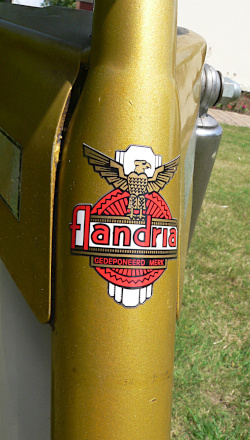
Flandria products were only briefly seen in the UK, until imports ceased in April 1976.
Superia moped assembly came to an end, and Remi Claeys’s steel tube manufacturing came to an end in 1978. However the tube plant remained in production with its complete focus now on aluminium products.
The continuing Flandria sales decline continued against its steadily losing battle against increasing imports of Japanese mopeds and motor cycles that were beginning to flood the market. Sales of Flandria bicycles also began to slip back, and by 1979 production had dwindled to just 32,000 p/a.
A.Claeys-Flandria sales were now failing to maintain a profit and, in May 1981, the company declared bankruptcy. Now some years following the passing of both Claeys brothers, and maybe ironically, Remi Claeys’s Superia Company, which hadn’t produced bicycles for years, purchased the A.Claeys Flandria brand from receivership!
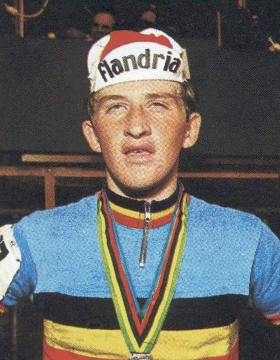
Freddy Maertens
Following the quarter-of-a-century unresolved feud, the dividing wall in the factory was finally taken down, and bicyles would now be produced under the reconnected Superia–Flandria brand.
The high times had however passed, and the brand could never return to its former glories … in 1986 the production of Superia-Flandria bicycles ended, and the famous Belgian Flandria brand sadly disappeared from the marketplace. Many cycling legends had raced in the red and white colours of Flandria, the most famous being double World Champion Freddy Maertens, who holds the record for the most professional victories in a single season. Maertens recorded 54 victories in 1976, equalling the previous record set by Eddy Merckx 5 years earlier.
Flandria’s lawn mower department was also absorbed by Superia, who continued to sell mowers under Flandria branding until 1989, when the lawn mower and radiator departments (still located in Zedelgem), were taken over by the Swedish Stiga Company, who merged it into Global Garden Products. Stiga divested the radiator department on to Dutch entrepreneur Fons Walder in 1991, who kept the name of Superia Radiators till the business was sold on to the American Masco Company in 1999.
Stiga closed down all production activities at Zedelgem in 2003, and in this same year SAPA acquired Remi Claeys Aluminium.
In 2002 the Flandria cycle trademark was bought by Englishman, Adam Longworth, as a passionate racing cyclist on a self appointed mission to restore the Flandria name and return the brand to cycle sport using the latest modern materials and processes, from which Flandria cycles became re-launched in the UK in 2004.
Consultations with Freddy Maertens in 2008 toward development of a second generation of Flandria bikes resulted in a new range of Belgian-designed Flandria frames in 2010 being unveiled in Belgium. Paul Claeys, Aimé’s son, and former boss of Flandria, inspected the new Flandria range and gave his enthusiastic approval, reporting he was pleased to see the Flandria name back on bicycles.
In 2013, a joint venture between SAPA & Hydro aluminium companies was announced, and the business trading name changed to Hydro Precision Tubing Lichtervelde NV in 2018.
In August 2021, Aurelius Equity Opportunities acquired Hydro Precision Tubing Lichtervelde, and the company name was returned to Remi Claeys Aluminium NV.
Since 2000, the French Flandria company had continued to develop under the presidency of Paul and Ignace Vandenbroucke, by adding new capabilities and activities such as the machining of aluminium profiles to its extrusion and recycling of aluminium profiles, and latterly directed by Jean-Marie Chuffart and Sabine and Julie Vandenbroucke.
As of Monday 28th August 2023 it was notified that Exlabesa has taken over the Flandria group.

